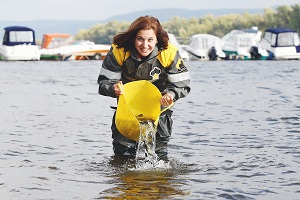Please activate JavaScript in your browser to use all interface options.
Rosneft Enterprises Release over 65 Million Fry into Russian Rivers in 2020
19 January 2021
Over 2020, subsidiaries of Rosneft Oil Company have released more than 65 juvenile fish of various species into the river systems of Russia.
According to the Rosneft 2022 Strategy, the Company is determined to gain the world industry leadership in the safety and environment. One of Rosneft’s main priorities is the conservation of biodiversity and ecosystems in the regions where the Company operates, including the replenishment of fish resources. The fry are released into the natural environment as part of programmes for the artificial reproduction of aquatic biological resources.
The biggest contributor to the conservation and enhancement of fish fauna was RN-Yuganskneftegaz, Rosneft’s largest production enterprise. Upon request from RN-Yuganskneftegaz, more than 50 million juvenile fish, including valuable local fish species such as Siberian sturgeon, muksun and peled, were raised in hatcheries. The fry were released into the rivers of the Ob-Irtysh basin.
Taas-Yuryakh Neftegazodobycha, the subsidiary engaged in oil production in the Republic of Sakha (Yakutia), has been increasing the scale of annual campaigns on stocking the Vilyui Reservoir in Mirny District. The enterprise released about 800,000 fry of the whitefish species, the peled, into a tributary of the Akhtaranda River. Upon request from Taas-Yuryakh Neftegazodobycha, the fry is grown by the Chernyshevsky fish farm. The fry are hatched in conditions as close to natural as possible, ‑with water taken from the Vilyui Reservoir.
In 2020, 700,000 juvenile fish, including those of sturgeon, were released into the waters of the Volga River and rivers of the Volga basin. The Syzran Refinery, Kuibyshev Refinery, Saratov Refinery, Novokuibyshevsk Refinery and other enterprises of the Company held traditional environmental campaigns for the artificial reproduction of aquatic biological resources. The programme on artificial reproduction of aquatic biological resources is based upon the results of the fisheries and habitat assessment by the Volga Basin Ecology Institute of the Russian Academy of Sciences and the Saratov branch of the Russian Research Institute of Fisheries and Oceanography, as well as from the conclusions of the Middle Volga and Volga-Caspian Territorial Departments of the Federal Agency for Fishery. Upon request from the Syzran Refinery, sturgeon fry were hatched at the Holy Virgin Kazan Monastery in the Vinnovka settlement, which has many years of experience in farming rare red-listed fish.
RN-Vankor was the first to release over 250,000 Siberian sturgeon fry into the Yenisei River. Siberian sturgeon is a valuable, red-listed species. The young sturgeons grown on request of RN-Vankor by local fish hatcheries were released into the river near the towns of Dudinka and Yeniseisk, Krasnoyarsk Krai. According to ichthyologists, this is where fry adaptation is most favourable. The number of Siberian sturgeon inhabiting the Yenisei River has fallen sharply in recent years due to anthropogenic impacts, unsustainable fishing and poaching. The addition of young sturgeon to the lower reaches of the Yenisei River will help to preserve the population.
The RN-Tuapse Refinery released over 6,000 Black Sea salmon fry into the Mzymta River (the Black Sea basin). This scarce subspecies of the salmon family is listed in the Red Book of Russia and is quite rare in most rivers of the Black Sea coast. The Tuapse Refinery is working to protect, artificially reproduce and reintroduce the fish species.
In 2020, more than 60 Rosneft subsidiaries arranged and participated in aquatic biological resources reproduction activities to preserve and increase fish fauna.
Rosneft
Information Division
January 19, 2021

-315xx70.png)

